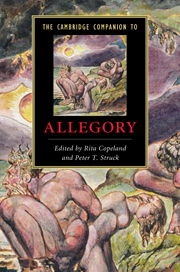Book contents
- Frontmatter
- Introduction
- Part I: Ancient foundations
- Part II: Philosophy, theology, and poetry 200 to 1200
- Part III: Literary allegory: philosophy and figuration
- Part IV: The fall and rise of allegory
- 15 Romanticism’s errant allegory
- 16 American allegory to 1900
- 17 Walter Benjamin’s concept of allegory
- 18 Hermeneutics, deconstruction, allegory
- 19 Allegory happens: allegory and the arts post-1960
- Further reading
- Index
19 - Allegory happens: allegory and the arts post-1960
from Part IV: - The fall and rise of allegory
Published online by Cambridge University Press: 28 January 2011
- Frontmatter
- Introduction
- Part I: Ancient foundations
- Part II: Philosophy, theology, and poetry 200 to 1200
- Part III: Literary allegory: philosophy and figuration
- Part IV: The fall and rise of allegory
- 15 Romanticism’s errant allegory
- 16 American allegory to 1900
- 17 Walter Benjamin’s concept of allegory
- 18 Hermeneutics, deconstruction, allegory
- 19 Allegory happens: allegory and the arts post-1960
- Further reading
- Index
Summary
Allegory, as others in this volume have explored, is derived from allôs and agoreuein, signifying “other speaking,” other than what is said, or, what is not said. Because of the interest in “otherness” in the cultural, social and philosophical contexts of many Western academic disciplines, much of the recent discussion and development of allegory has been toward issues of difference and absence. Most of the critics turning their attention to the topic quickly cast aside the relationship of allegory to one-on-one emblem, or “naïve” allegory. Similarly, the connections with fable, a genre that plots the associations between A and B, and even with irony, which uses techniques similar to those found in allegory to convey the common grounds needed for ironic or satirical reflection, are not much pursued. Allegory fascinates those who want to explore the complexities and difficulties of speaking about the not-said, or more interesting, the not-yet-said. Allegory has come to be perceived as a rhetorical stance, one that in literature includes the writer, the words and the reader into a reading event called “text” or textuality. It is not a thing but an event that happens. Any one piece of writing may be an allegory if the reading constitutes it as such, while at another time it may be read more generically as utopian or satirical or even realist.
- Type
- Chapter
- Information
- The Cambridge Companion to Allegory , pp. 266 - 280Publisher: Cambridge University PressPrint publication year: 2010
- 19
- Cited by

